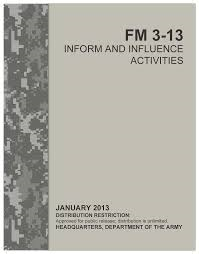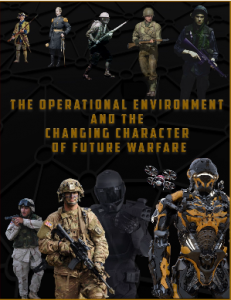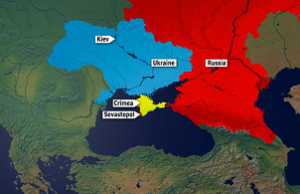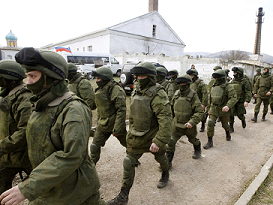[Editor’s Note: Mad Scientist Laboratory is pleased to present today’s guest post by Ms. Taylor Galanides, TRADOC G-2 Summer Intern, exploring how the increasing momentum of human interaction, events, and actions, driven by the convergence of innovative technologies, is enabling adversaries to exploit susceptibilities and vulnerabilities to manipulate populations and undermine national interests. Ms. Galanides examines contemporary Information Operations as a harbinger of virtual warfare in the future Operational Environment.]
 More information is available than ever before. Recent and extensive developments in technology, media, communication, and culture – such as the advent of social media, 24-hour news coverage, and smart devices – allow people to closely monitor domestic and foreign affairs. In the coming decades, the increased speed of engagements, as well as the precise and pervasive targeting of both civilian and military populations, means that these populations and their respective nations will be even more vulnerable to influence and manipulation attempts, misinformation, and cyber-attacks from foreign adversaries.
More information is available than ever before. Recent and extensive developments in technology, media, communication, and culture – such as the advent of social media, 24-hour news coverage, and smart devices – allow people to closely monitor domestic and foreign affairs. In the coming decades, the increased speed of engagements, as well as the precise and pervasive targeting of both civilian and military populations, means that these populations and their respective nations will be even more vulnerable to influence and manipulation attempts, misinformation, and cyber-attacks from foreign adversaries.
 The value of influencing and shaping the perceptions of foreign and domestic populations in order to pursue national and military interests has long been recognized. This can be achieved through the employment of information operations, which seek to affect the decision-making process of adversaries. The U.S. Army views information operations as an instrumental part of the broader effort to maintain an operational advantage over adversaries. Information operations is specifically defined by the U.S. Army as “The integrated employment, during military operations, of information-related capabilities in concert with other lines of operation to influence, disrupt, corrupt, or usurp the decision-making of adversaries and potential adversaries while protecting our own.”
The value of influencing and shaping the perceptions of foreign and domestic populations in order to pursue national and military interests has long been recognized. This can be achieved through the employment of information operations, which seek to affect the decision-making process of adversaries. The U.S. Army views information operations as an instrumental part of the broader effort to maintain an operational advantage over adversaries. Information operations is specifically defined by the U.S. Army as “The integrated employment, during military operations, of information-related capabilities in concert with other lines of operation to influence, disrupt, corrupt, or usurp the decision-making of adversaries and potential adversaries while protecting our own.”
 The U.S. Army Training and Doctrine Command (TRADOC) G-2’s The Operational Environment and the Changing Character of Future Warfare further emphasizes this increased attention to the information and cognitive domains in the future – in the Era of Contested Equality (2035 through 2050). As a result, it has been predicted that no single nation will hold hegemony over its adversaries, and major powers and non-state actors alike “… will engage in a fight for information on a global scale.” Winning preemptively in the competitive dimension before escalation into armed conflict through the use of information and psychological warfare will become key.
The U.S. Army Training and Doctrine Command (TRADOC) G-2’s The Operational Environment and the Changing Character of Future Warfare further emphasizes this increased attention to the information and cognitive domains in the future – in the Era of Contested Equality (2035 through 2050). As a result, it has been predicted that no single nation will hold hegemony over its adversaries, and major powers and non-state actors alike “… will engage in a fight for information on a global scale.” Winning preemptively in the competitive dimension before escalation into armed conflict through the use of information and psychological warfare will become key.

Part of the driving force that is changing the character of warfare includes the rise of innovative technologies such as computer bots, artificial intelligence, and smart devices. Such emerging and advancing technologies have facilitated the convergence of new susceptibilities to individual and international security; as such, it will become increasingly more important to employ defensive and counter information operations to avoid forming misperceptions or being deceived.
Harbinger of the Future: Information Operations in Crimea
 Russia’s invasion of eastern Ukraine and subsequent annexation of Crimea in 2014 effectively serve as cautionary examples of Russia’s evolving information operations and their perception-shaping capabilities. In Crimea, Russia sought to create a “hallucinating fog of war” in an attempt to alter the analytical judgments and perceptions of its adversaries. With the additional help of computer hackers, bots, trolls, and television broadcasts, the Russian government was able to create a manipulated version of reality that claimed Russian intervention in Crimea was not only necessary, but humanitarian, in order to protect Russian speakers. Additionally, Russian cyberespionage efforts included the jamming or shutting down of telecommunication infrastructures, important Ukrainian websites, and cell phones of key officials prior to the invasion. Through the use of large demonstrations called “snap exercises,” the Russians were able to mask military buildups along the border, as well as its political and military intentions. Russia further disguised their intentions and objectives by claiming adherence to international law, while also claiming victimization from the West’s attempts to destabilize, subvert, and undermine their nation.
Russia’s invasion of eastern Ukraine and subsequent annexation of Crimea in 2014 effectively serve as cautionary examples of Russia’s evolving information operations and their perception-shaping capabilities. In Crimea, Russia sought to create a “hallucinating fog of war” in an attempt to alter the analytical judgments and perceptions of its adversaries. With the additional help of computer hackers, bots, trolls, and television broadcasts, the Russian government was able to create a manipulated version of reality that claimed Russian intervention in Crimea was not only necessary, but humanitarian, in order to protect Russian speakers. Additionally, Russian cyberespionage efforts included the jamming or shutting down of telecommunication infrastructures, important Ukrainian websites, and cell phones of key officials prior to the invasion. Through the use of large demonstrations called “snap exercises,” the Russians were able to mask military buildups along the border, as well as its political and military intentions. Russia further disguised their intentions and objectives by claiming adherence to international law, while also claiming victimization from the West’s attempts to destabilize, subvert, and undermine their nation.
 By denying any involvement in Crimea until after the annexation was complete, distorting the facts surrounding the situation, and refraining from any declaration of war, Russia effectively infiltrated the international information domain and shaped the decision-making process of NATO countries to keep them out of the conflict. NATO nations ultimately chose minimal intervention despite specific evidence of Russia’s deliberate intervention in order to keep the conflict de-escalated. Despite the West’s refusal to acknowledge the annexation of Crimea, it could be argued that Russia achieved their objective of expanding its sphere of influence.
By denying any involvement in Crimea until after the annexation was complete, distorting the facts surrounding the situation, and refraining from any declaration of war, Russia effectively infiltrated the international information domain and shaped the decision-making process of NATO countries to keep them out of the conflict. NATO nations ultimately chose minimal intervention despite specific evidence of Russia’s deliberate intervention in order to keep the conflict de-escalated. Despite the West’s refusal to acknowledge the annexation of Crimea, it could be argued that Russia achieved their objective of expanding its sphere of influence.
Vulnerabilities and Considerations
Russia is the U.S.’ current pacing threat, and China is projected to overtake Russia as the Nation’s primary threat as early as 2035. It is important to continue to evaluate the way that the U.S. and its Army respond to adversaries’ increasingly technological attempts to influence, in order to maintain the information and geopolitical superiority of the Nation. For example, the U.S. possesses different moral and ethical standards that restrict the use of information operations. However, because adversarial nations like Russia and China pervasively employ influence and deceptive measures in peacetime, the U.S. and its Army could benefit from developing alternative methods for maintaining an operational advantage against its adversaries.

Adversarial nations can also take advantage of “the [Western] media’s willingness to seek hard evidence and listen to both sides of an argument before coming to a conclusion” by “inserting fabricated or prejudicial information into Western analysis and blocking access to evidence.” The West’s free press will continue to be the primary counter to constructed narratives. Additionally, extensive training of U.S. military and Government personnel, in conjunction with educating its civilian population about Russia and China’s deceitful narratives may decrease the likelihood of perceptions being manipulated: “If the nation can teach the media to scrutinize the obvious, understand the military, and appreciate the nuances of deception, it may become less vulnerable to deception.” Other ways to exploit Russian and Chinese vulnerabilities could include taking advantage of poor operations security, as well as the use and analysis of geotags to refute and discredit Russian and Chinese propaganda narratives.
A final consideration involves the formation of an interagency committee, similar to the Active Measures Working Group from the 1980s, for the identification and countering of adversarial disinformation and propaganda. The coordination of the disinformation efforts by manipulative countries like Russia is pervasive and exhaustive. Thus, coordination of information operations and counter-propaganda efforts is likewise important between the U.S. Government, the Army, and the rest of the branches of the military. The passing of the Countering Foreign Propaganda and Disinformation Act, part of the 2017 National Defense Authorization Act, was an important first step in the continuing fight to counter foreign information and influence operations that seek to manipulate the U.S. and its decision-makers and undermine its national interests.
For more information on how adversaries will seek to shape perception in the Future Operational Environment, read the following related blog posts:
Influence at Machine Speed: The Coming of AI-Powered Propaganda
Virtual War – A Revolution in Human Affairs (Part I)
Taylor Galanides is a Junior at The College of William and Mary in Virginia, studying Psychology. She is currently interning at Headquarters, U.S. Army Training and Doctrine Command (TRADOC) with the G-2 Futures team.




Interesting post and good to see young minds involved with this blog. A couple of observations:
1. Not sure how applicable Russia’s information actions vis-à-vis Ukraine/Crimea support the author’s thesis. The overwhelming majority of ethnic Russians living in Crimea had been advocating for greater Kremlin control ever since the USSR collapsed in 1991. In early 2014, the Kremlin needed no assistance in convincing these ethnic Russians that their lives would improve under Russian ownership. The interim Ukrainian government screwed up big when it initially advocated a change to the country’s language law (later rescinded). Moscow was able to exploit this blunder by falsely asserting that the new government in Kiev would force the entire population to learn/use Ukrainian.
2. Given the pro-Russian attitudes in Crimea in March 2014, I think that the US Military may have drawn some erroneous conclusions regarding the prowess of the Russian military/info operations. This incident is likely not a “harbinger of the future.”
3. The author may want to go back and review the events of early 2014. Russia annexed Crimea before it moved para-military forces into SE Ukraine, and so her assertion that “Russia’s invasion of eastern Ukraine and subsequent annexation of Crimea in 2014” is incorrect.
4. As mentioned above, given the popular attitude among ethnic Russians in Crimea in March 2014, the Kremlin had no need to “create a hallucinating fog of war.”
5. The snap exercises which the Russian military conducted in Spring-Summer 2014 made it loud and clear that they were willing to support the separatists in the Donbas. These intentions were not “masked.”
Mr. Finch,
I greatly appreciate your observations and comments. First, I was trying to highlight Russia’s evolving information operations. As for the Crimea example, I was trying to highlight not their attempts to influence Crimeans (as many were pro-Russian already), but their attempts to confuse and influence the international community, especially NATO countries, at large. I attempted to convey this idea with this section of the blog: “By denying any involvement in Crimea until after the annexation was complete, distorting the facts surrounding the situation, and refraining from any declaration of war, Russia effectively infiltrated the international information domain and shaped the decision-making process of NATO countries to keep them out of the conflict. NATO nations ultimately chose minimal intervention despite specific evidence of Russia’s deliberate intervention in order to keep the conflict de-escalated.”
With this perspective, Russia was trying to “create a hallucinating fog of war” within the international community.
I realize that you possess an extensive expertise on this subject. However, as for your 3rd point, I believe that it could be argued that Russia sent troops into Ukraine prior to annexation
(depending on how one defines ‘troops’ or ‘forces’). From timelines that I have found online, it looks like armed ‘unidentified’ forces occupied Crimean parliament buildings, airports, and other buildings, in late February, and in March, Russia formally annexed Crimea between the 17th and 21st (https://www.jstor.org/stable/10.5305/amerjintelaw.109.1.0068).
http://www.atlanterhavskomiteen.no/files/dnak/Documents/Publikasjoner/2015/Sikkerhetspolitisk%20Bibliotek/NR%204-15%2014.%20august.pdf
http://ukraine.csis.org/crimea.htm#3
Again, the perspective that I am viewing these events was from the perspective of how Russia was trying to mask their intentions to the broader global community. For example, while conducting massive military buildups and exercises along the border, they ‘claimed’ to be “checking troop readiness for crisis scenarios.” (http://time.com/9824/russia-orders-troop-maneuvers-amid-ukraine-tensions/). While viewing these events in hindsight, it is easy to see Russia’s true intentions, but I believe many Western, and even American, officials and leaders misperceived the events while they were occurring.
Thank you again for sharing your thoughts.